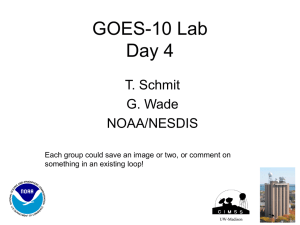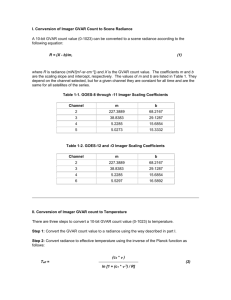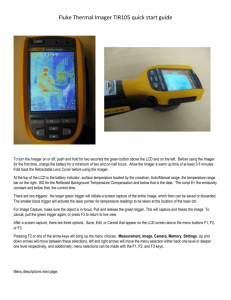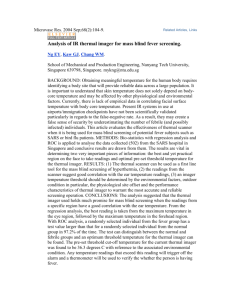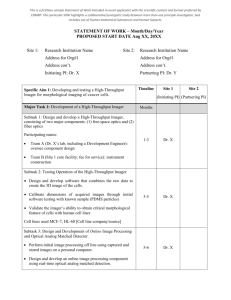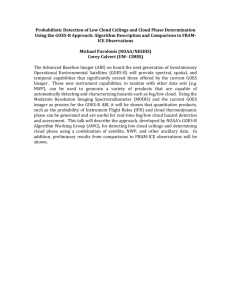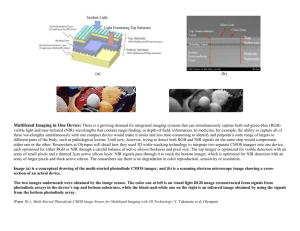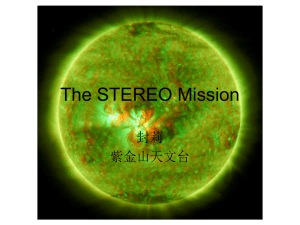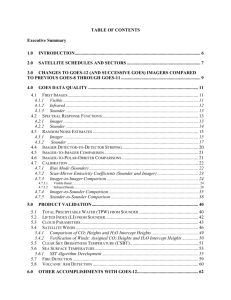Conversion of GVAR Infrared Data to Scene Radiance or Temperature
advertisement
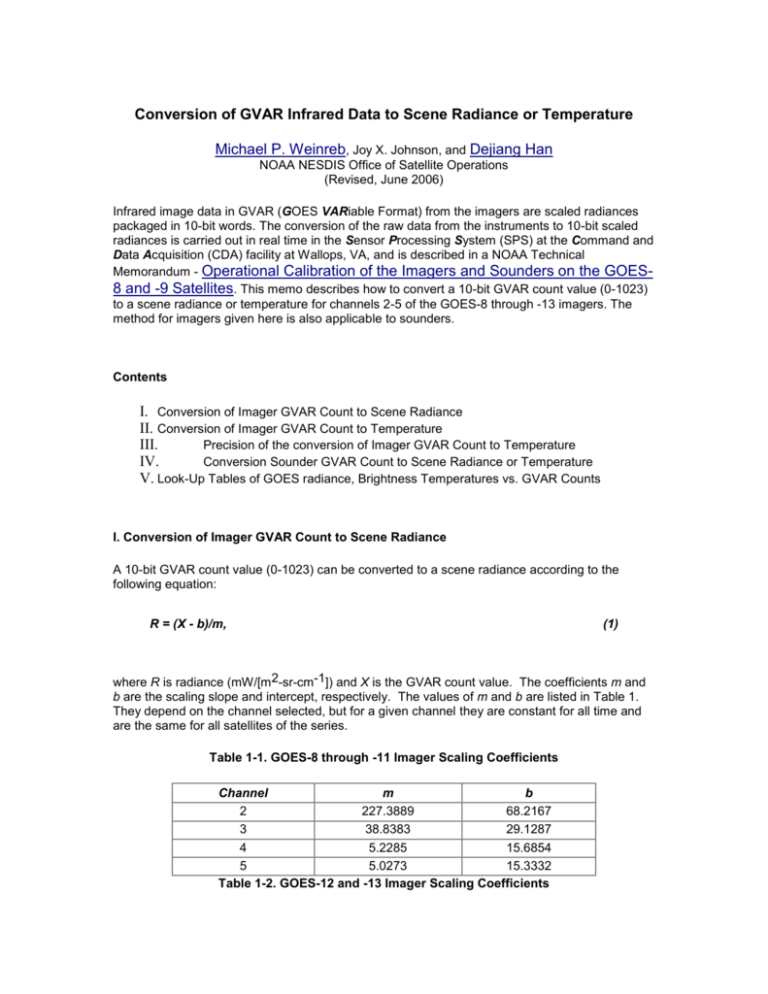
Conversion of GVAR Infrared Data to Scene Radiance or Temperature Michael P. Weinreb, Joy X. Johnson, and Dejiang Han NOAA NESDIS Office of Satellite Operations (Revised, June 2006) Infrared image data in GVAR (GOES VARiable Format) from the imagers are scaled radiances packaged in 10-bit words. The conversion of the raw data from the instruments to 10-bit scaled radiances is carried out in real time in the Sensor Processing System (SPS) at the Command and Data Acquisition (CDA) facility at Wallops, VA, and is described in a NOAA Technical Memorandum - Operational Calibration of the Imagers and Sounders on the GOES8 and -9 Satellites. This memo describes how to convert a 10-bit GVAR count value (0-1023) to a scene radiance or temperature for channels 2-5 of the GOES-8 through -13 imagers. The method for imagers given here is also applicable to sounders. Contents I. Conversion of Imager GVAR Count to Scene Radiance II. Conversion of Imager GVAR Count to Temperature III. Precision of the conversion of Imager GVAR Count to Temperature IV. Conversion Sounder GVAR Count to Scene Radiance or Temperature V. Look-Up Tables of GOES radiance, Brightness Temperatures vs. GVAR Counts I. Conversion of Imager GVAR Count to Scene Radiance A 10-bit GVAR count value (0-1023) can be converted to a scene radiance according to the following equation: R = (X - b)/m, (1) where R is radiance (mW/[m 2-sr-cm-1]) and X is the GVAR count value. The coefficients m and b are the scaling slope and intercept, respectively. The values of m and b are listed in Table 1. They depend on the channel selected, but for a given channel they are constant for all time and are the same for all satellites of the series. Table 1-1. GOES-8 through -11 Imager Scaling Coefficients Channel m b 2 227.3889 68.2167 3 38.8383 29.1287 4 5.2285 15.6854 5 5.0273 15.3332 Table 1-2. GOES-12 and -13 Imager Scaling Coefficients Channel 2 3 4 6 m 227.3889 38.8383 5.2285 5.5297 b 68.2167 29.1287 15.6854 16.5892 II. Conversion of Imager GVAR count to Temperature There are three steps to convert a 10-bit GVAR count value (0-1023) to temperature. Step 1: Convert the GVAR count value to a radiance using the way described in part I. Step 2: Convert radiance to effective temperature using the inverse of the Planck function as follows: (c2 * ) _____________________________ ln [1 + (c1 * 3) / R] Teff = (2) c1 = 1.191066 x 10-5 [mW/(m2-sr-cm-4)] c2 = 1.438833 (K/cm-1) where Teff is effective temperature (K), ln stands for natural logarithm, and R is radiance. The coefficients , c1, and c2 are the central wavenumber of the channel and the two radiation constants, respectively. The constants c1 and c2 are invariant, but depends on the spectral characteristics of the channel and will vary from instrument to instrument. Step 3: Convert effective temperature Teff to actual temperature T (K) using the following equation: T = + * Teff (3) where and are two conversion coefficients. Note in the conversions that: The values of (cm-1) in step 2 and constants and in step 3 depend on channel and instrument. Their values are listed below in Tables 2-1 through 2-5. The term side 1 or side 2 in the table headings indicates the operation of one of the two redundant sets of detectors and electronics on each imager. The coefficients , , and depend on the choice of side. The GOES-8, -9, -11, and -12 imagers have always operated on side 1. The GOES-10 imager is operating on side 2. The GOES-13 imager is expect to operate on side 1 after launch in May, 2006. We will provide the coefficients for other electronics sides when they are needed. Table 2-1. GOES-8 Imager (Side 1) Coefficients Channel/Detector 2/a 2/b 3 4/a 4/b 5/a 5/b 2556.71 2558.62 1481.91 934.30 935.38 837.06 837.00 -0.578526 -0.581853 -0.593903 -0.322585 -0.351889 -0.422571 -0.466954 1.001512 1.001532 1.001418 1.001271 1.001293 1.001170 1.001257 Table 2-2. GOES-9 Imager (Side 1) Coefficients Channel/Detector 2/a 2/b 3 4/a 4/b 5/a 5/b 2555.18 2555.18 1481.82 934.59 934.28 834.02 834.09 -0.579908 -0.579908 -0.493016 -0.384798 -0.363703 -0.302995 -0.306838 1.000942 1.000942 1.001076 1.001293 1.001272 1.000941 1.000948 Table 2-3. GOES-10 Imager (Side 2) Coefficients Channel/Detector 2/a 2/b 3 4/a 4/b 5/a 5/b 2552.9845 2552.9845 1486.2212 936.10260 935.98981 830.88473 830.89691 -0.60584483 -0.60584483 -0.61653805 -0.27128884 -0.27064036 -0.26505411 -0.26056452 1.0011017 1.0011017 1.0014011 1.0009674 1.0009687 1.0009087 1.0008962 Table 2-4. GOES-11 Imager (Side 1) Coefficients Channel/Detector 2/a 2/b 3 2562.07 2562.07 1481.53 -0.644790 -0.644790 -0.543401 1.000775 1.000775 1.001495 4/a 4/b 5/a 5/b 931.76 931.76 833.67 833.04 -0.306809 -0.306809 -0.333216 -0.315110 1.001274 1.001274 1.001000 1.000967 Table 2-5. GOES-12 Imager (Side 1) Coefficients Channel/Detector 2/a 2/b 3/a 3/b 4/a 4/b 6 2562.45 2562.45 1536.43 1536.94 933.21 933.21 751.91 -0.650731 -0.650731 -4.764728 -4.775517 -0.360331 -0.360331 -0.253449 1.001520 1.001520 1.012420 1.012403 1.001306 1.001306 1.000743 Table 2-6. GOES-13 Imager (Side 1) Coefficients Channel/Detector 2/a 2/b 3/a 3/b 4/a 4/b 6 2561.74 2561.74 1522.52 1521.66 937.23 937.27 753.15 -1.437204 -1.437204 -3.625663 -3.607841 -0.386043 -0.380113 -0.195055 1.002562 1.002562 1.010018 1.010010 1.001298 1.001285 1.000610 III. Precision of the Conversion of Imager GVAR Count to Temperature The use of Teff accounts for the variation of the Planck function across the spectral passband of the channel. The differences between the values of T and Teff increase with decreasing temperature. They are usually of the order of 0.1 K. In the worst case, near 180 K, they are approximately 0.3 K. A change of one GVAR count is equivalent to a temperature change of approximately 0.11 K in channels 2,4,5, and 6 for a scene at 300K, and a change of approximately 0.04 K in channel 3 for a scene at 290 K. The errors resulting from the above approximations can be reduced by a factor of 10 if the following second-order polynomial is adopted: T = + * Teff + * Teff2 (4) This yields errors under 0.001 K, even at temperatures above 310 K or under 210 K. The , , and coefficients and centroid wavenumber for all detectors are listed in the tables 3-1a through 3-5a below: Table 3-1: GOES-8 imager Table 3-2: GOES-9 imager Table 3-3: GOES-10 imager Table 3-4: GOES-11 imager Table 3-5: GOES-12 imager Table 3-6: GOES-13 imager IV. Conversion of Sounder GVAR Count to Scene Radiance or Temperature As mentioned at the beginning of this memorandum, the methods described here to convert imager GVAR data to scene radiance or temperature are also applicable to GOES sounders. The GOES sounder scaling coefficients are listed in Table A2 of the above-mentioned NOAA Technical Memorandum - Operational Calibration of the Imagers and Sounders on the GOES-8 and -9 Satellites.. As described in the memorandum, infrared sounder data in GVAR are scaled radiances packaged in 16-bit words. The conversion of the raw data from the instruments to 16-bit scaled radiances is carried out in real time in the SPS at the CDA facility at Wallops, VA. The related coefficients (, , , and ) of GOES sounders for the first- and secondorder polynomials (Equations [3] and [4]) - are included in the following tables: Coefficients (, and ) for the first-order polynomial: Table 4-1a: GOES-8 sounder Table 4-2a: GOES-9 sounder Table 4-3a: GOES-10 sounder Table 4-4a: GOES-11 sounder Table 4-5a: GOES-12 sounder Table 4-6a: GOES-13 sounder Coefficients (, , , and ) for the second-order polynomial: Table 4-1b: GOES-8 sounder Table 4-2b: GOES-9 sounder Table 4-3b: GOES-10 sounder Table 4-4b: GOES-11 sounder Table 4-5b: GOES-12 sounder Table 4-6b: GOES-13 sounder V. Look-Up Tables of GOES radiances, Brightness Temperatures vs. GVAR Counts The GOES-8, GOES-9, GOES-10 GOES-11 and GOES-M Imager and Sounder look-up tables of radiances, brightness temperatures vs. GVAR counts are listed below. The look-up tables for the Imagers cover all the detectors, while the look-up tables for the Sounders only cover detector 1 for each infrared channel. This arrangement intends to avoid huge disk space the Sounder lookup tables might have occupied. Sounder look-up tables are arranged according to their channels and are also compressed. Imagers: Table 5-1a: GOES-8 Imager look-up table Table 5-2a: GOES-9 Imager look-up table Table 5-3a: GOES-10 Imager look-up table Table 5-4a: GOES-11 Imager look-up table Table 5-5a: GOES-12 Imager look-up table Table 5-6a: GOES-13 Imager look-up table Sounders: Table 5-1b: GOES-8 Sounder look-up table Table 5-2b: GOES-9 Sounder look-up table Table 5-3b: GOES-10 Sounder look-up table Table 5-4b: GOES-11 Sounder look-up table Table 5-5b: GOES-12 Sounder look-up table Table 5-6b: GOES-13 Sounder look-up table The mode - A count value Xa is derived from the temperature with the following equations3: For 163K <= T <= 242K, Xa = 418 - T. For 242K <= T <= 330K, Xa = 660 - 2T. Mode - A count values are on an eight-bit scale and range in value from 0 to 255, with high counts representative of low temperatures. Beyond the difference in precision, there is a fundamental difference between GVAR counts and mode-A counts--their units. GVAR counts are scaled radiances, whereas mode-A counts are temperatures. REFERENCES [1] Weinreb, M.P., M. Jamieson, N. Fulton, Y. Chen, J.X. Johnson, J. Bremer, C. Smith, and J. Baucom, "Operational calibration of Geostationary Operational Environmental Satellite-8 and -9 imagers and sounders," Applied Optics, 36, pp. 6895-6904, 1997. [2] Johnson, J.X., GOES-8 radiance to brightness-temperature conversions, internal memorandum, Sept. 20, 1996. [3] Bristor, C.L. (ed.), "Central processing and analysis of geostationary satellite data," NOAA Tech. Memo. NESS 64, U.S. Dep't. Commerce, National Oceanic and Atmospheric Administration, Washington, DC, 155 pp. (1975)
